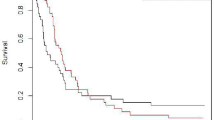Abstract
Having spent almost 30 years since Lee and Nelder introduced the h-likelihood at the discussion meeting held in Royal Statistical Society in 1994, Lee and his colleagues and students have studied how to define the h-likelihood for complex statistical models and conduct inference about unobservables and fixed unknown parameters in them. In this paper we review several important research areas with a focus on how the h-likelihood method has been applied. This review covers areas including analysis of clustered survival data, competing risk models with frailty, joint models for longitudinal and survival outcomes, sparse high-dimensional multivariate analysis, spatial analysis and multiple testing.

Similar content being viewed by others
References
Balan, T. A., & Putter, H. (2020). A tutorial on frailty models. Statistical Methods in Medical Research, 29, 3424–3454.
Benjamini, Y., & Hochberg, Y. (1995). Controlling the false discovery rate: A practical and powerful approach to multiple testing. Journal of the Royal Statistical Society: Series B, 57, 289–300.
Berger, J.O. & Wolpert, R.L. (1988). The likelihood principle, IMS Lecture Notes Monogr. Ser., 6.
Besag, J. (1974). Spatial Interaction and the Statistical Analysis of Lattice Systems (with discussion). J R Statist Soc B, 36, 192–236.
Besag, J., & Kempton, R. (1986). Statistical analysis of field experiments using neighbouring plots. Biometrics, 42, 231–251.
Besag, J., & Kooperberg, C. (1995). On conditional and intrinsic autoregressions. Biometrika, 82, 733–746.
Bjørnstad, J. F. (1996). On the Generalization of the Likelihood Function and the Likelihood Principle. Journal of the American Statistical Association, 91, 791–806.
Breslow, N. E. (1972). Discussion of the paper by D. R. Cox. Journal of the Royal Statistical Society: Series B, 34, 216–217.
Christian, N. J., Ha, I. D., & Jeong, J. H. (2016). Hierarchical likelihood inference on clustered competing risks data. Statistics in Medicine, 35, 251–267.
Duchateau, L., & Janssen, P. (2008). The frailty model. Springer.
Durbin, J., & Koopman, S. J. (2001). Time series analysis by state space methods. Oxford University Press.
Diggle, P. J., Liang, K. Y., & Zeger, S. L. (1994). Analysis of Longitudinal Data. Oxford University Press.
Diggle, P. J., Tawn, J. A., & Moyeed, R. A. (1998). Model-based geostatistics (with discussion). Applied Statistics, 47, 299–350.
Efron, B. (2004). Large-scale simultaneous hypothesis testing: The choice of a null hypothesis. Journal of the American Statistical Association, 99, 96–104.
Elliot, H., Derin, H., Christi, R., & Geman, D. (1984). Application of the Gibbs distribution to image segmentation. In: Proceedings of the International Conference on Acoustics, Speech and Signal Processing, San Diego, IEEE.
Fan, J., & Li, R. (2001). Variable selection via nonconcave penalized likelihood and its oracle properties. Journal American Statistical Association, 96, 1348–1360.
Fine, J. P., & Gray, R. J. (1999). A proportional hazards model for the subdistribution of a competing risk. Journal of the American Statistical Association, 94, 496–509.
Fisher, R. A. (1921). On the ‘probable error’ of a coefficient of correlation deduced from a small sample. Metron, 1, 1–32.
Golub, G. H., & Reinsch, C. (1971). Singular value decomposition and least squares solutions. Numerische Mathematik, 14, 403–420.
Green, P. J., & Silverman, B. W. (1984). Nonparametric regression and generalized linear models: a roughness penalty approach. Chapman & Hall.
Green, P., Christopher, J., & Seheult, A. (1985). Analysis of field experiments by least squares smoothing. Journal of the Royal Statistical Society: Series B, 47, 299–315.
Ha, I. D., Lee, Y., & Song, J. K. (2001). Hierarchical likelihood approach for frailty models. Biometrika, 88, 233–243.
Ha, I. D., & Lee, Y. (2003). Estimating frailty models via Poisson hierarchical generalized linear models. Journal of Computational and Graphical Statistics, 12, 663–681.
Ha, I. D., Lee, Y., & MacKenzie, G. (2007). Model selection for multi-component frailty models. Statistics in Medicine, 26, 4790–4807.
Ha, I. D., Noh, M., & Lee, Y. (2010). Bias reduction of likelihood estimators in semi-parametric frailty models. Scandinavian Journal of Statistics, 37, 307–320.
Ha, I. D., Sylvester, R., Legrand, C., & MacKenzie, G. (2011). Frailty modelling for survival data from multi-centre clinical trials. Statistics in Medicine, 30, 2144–2159.
Ha, I. D., Noh, M., & Lee, Y. (2012). frailtyHL: A package for fitting frailty models with h-likelihood. R Journal, 4, 307–320.
Ha, I. D., Pan, J., Oh, S., & Lee, Y. (2014). Variable selection in general frailty models using penalized h-likelihood. Journal of Computational and Graphical Statistics, 23, 1044–1060.
Ha, I. D., Lee, M., Oh, S., Jeong, J. H., Sylvester, R., & Lee, Y. (2014). Variable selection in subdistribution hazard frailty models with competing risks data. Statistics in Medicine, 33, 4590–4604.
Ha, I. D., Christian, N. J., Jeong, J. H., Park, J., & Lee, Y. (2016). Analysis of clustered competing risks data using subdistribution hazard models with multivariate frailties. Statistical Methods in Medical Research, 25, 2488–2505.
Ha, I. D., Vaida, F., & Lee, Y. (2016). Interval estimation of random effects in proportional hazards models with frailties. Statistical Methods in Medical Research, 25, 936–953.
Ha, I. D., Jeong, J. H., & Lee, Y. (2017). Statistical modelling of survival data with random effects: h-likelihood approach. Springer.
Ha, I. D., Noh, M., & Lee, Y. (2017). H-likelihood approach for joint modelling of longitudinal outcomes and time-to-event data. Biometrical Journal, 59, 1122–1143.
Ha, I.D., Noh, M., Kim, J. & Lee, Y. (2018). frailtyHL: Frailty models using h-likelihood. http://CRAN.Rproject.org/package=frailtyHL. R package version 2.1.
Ha, I. D., Lee, Y., Xiang, L., Peng, M., & Jeong, J. H. (2020). Frailty modelling approaches for semi-parametric risks data. Lifetime Data Analysis, 26, 109–133.
Hougaard, P. (2000). Analysis of multivariate survival data. Springer.
Huang, R., Xiang, L., & Ha, I. D. (2019). Frailty proportional mean residual life regression for clustered survival data: A hierarchical quasi-likelihood method. Statistics in Medicine, 38, 4854–4870.
Jin, S., & Lee, Y. (2020). A review of h-likelihood and hierarchical generalized linear model. WIREs Computational Statistics,. https://doi.org/10.1002/wics.1527.
Kalbfleisch, J. D., & Prentice, R. (1982). The statistical analysis of failure time data. Wiley.
Laird, N. M., & Ware, J. H. (1982). Random-effects models for longitudinal data. Biometrics, 38, 963–974.
Lee, D., Lee, W., Lee, Y., & Pawitan, Y. (2010). Super sparse principal component analysis for high-throughput genomic data. BMC Bioinformatics, 11, 296.
Lee, D., Lee, W., Lee, Y., & Pawitan, Y. (2011). Sparse partial least-squares regression and its applications to high-throughput data analysis. Chemometrics and Intelligent Lab Systems, 109, 1–8.
Lee, D., Kang, H., Kim, E., et al. (2015). Optimal likelihood-ratio multiple testing with application to Alzheimer’s disease and questionable dementia. BMC Medical Research Methodology, 15, 9.
Lee, D., & Lee, Y. (2016). Extended likelihood approach to multiple testing with directional error control under a hidden Markov random field model. Journal of Multivariate Analysis, 151, 1–13.
Lee, D., Choi, D., & Lee, Y. (2020). Clustering with varying risks of false assignments in discrete latent variable model. Statistical Methods in Medical Research, 29(10), 2932–2944.
Lee, W., Lee, D., Lee, Y., & Pawitan, Y. (2011). Sparse canonical covariance analysis for high-throughput data. Statistical Applications in Genetics and Molecular Biology, 10(1), Article 30.
Lee, W., Lim, J., Lee, Y., & Castillo, J. D. (2011). The hierarchical-likelihood approach to autoregressive stochastic volatility models. Computational Statistics & Data Analysis, 55, 248–260.
Lee, W., & Lee, Y. (2013). Random-effect models with singular precision. Journal of Statistical Planning and Inference, 143, 2128–2141.
Lee, Y., & Nelder, J. A. (1996). Hierarchical generalized linear models (with discussion). Journal of the Royal Statistical Society: Series B, 58, 619–678.
Lee, Y., & Nelder, J. A. (2001). Hierarchical generalised linear models: A synthesis of generalised linear models, random-effect model and structured dispersion. Biometrika, 88, 987–1006.
Lee, Y., & Nelder, J. A. (2006). Double hierarchical generalized linear models (with discussion). Applied Statistics, 55, 139–185.
Lee, Y., Nelder, J. A., & Pawitan, Y. (2006). Generalized linear models with random effects: Unified analysis via H-likelihood. Chapman and Hall.
Lee, Y., & Nelder, J. A. (2009). Likelihood inference for models with unobservables: Another view (with discussion). Statistical Science, 24, 255–293.
Lee, Y., & Bjø rnstad, J. F. (2013). Extended likelihood approach to large-scale multiple testing. Journal of the Royal Statistical Society: Series B, 75, 553–575.
Lee, Y., & Oh, H.-S. (2014). A new sparse variable selection via random-effect model. Journal of Multivariate Analysis, 125, 89–99.
Lee, Y., Nelder, J. A., & Pawitan, Y. (2017). Generalized linear models with random effects: Unified analysis via H-likelihood (2nd ed.). Chapman and Hall.
Lee, Y., Rönnegȧrd, L., & Noh, M. (2017). Data Analysis Using Hierarchical Generalized Linear Models with R. CRC Press.
Lee, Y., & Kim, G. (2019). Properties of H-likelihood estimators in clustered data. International Statistical Review, 88, 380–395.
Meng, X. (2009). Decoding the H-likelihood. Statistical Science, 24, 280–293.
Park, E., & Ha, I. D. (2019). Penalized variable selection for accelerated failure time models with random effects. Statistics in Medicine, 38, 878–892.
Pawitan, Y., & Lee, Y. (2017). Wallet game: Probability, likelihood, and extended likelihood. The American Statistician, 71(2), 120–122.
Pawitan, Y., & Lee, Y. (2021). Confidence as likelihood. Statistical Science (to appear).
Pawitan, Y., Lee, H., & Lee, Y. (2021). Epistemic confidence, the Ducth book and relevant subsets. (Manuscript prepared for publication).
Rizopoulos, D. (2012). Joint models for longitudinal and time-to-event data, with applications in R. Chapman and Hall.
Sun, W., & Cai, T. T. (2007). Oracle and adaptive compound decision rules for false discovery rate control. Journal of the American Statistical Association, 102, 901–912.
Ter Braak, C. J. F., & de Jong, S. (1998). The objective function of partial least squares regression. Journal of Chemometrics, 12, 41–54.
Therneau, T. M., & Grambsch, P. M. (2000). Modeling survival data: Extending the Cox model. Springer.
Tibshirani, R. (1996). Regression Shrinkage and Selection via the Lasso. Journal of the Royal Statistical Society: Series B, 58, 267–288.
Zou, H., & Hastie, T. (2005). Regularization and variable selection via the elastic net. Journal of the Royal Statistical Society: Series B, 67, 301–320.
Acknowledgements
Woojoo Lee was supported by the National Research Foundation of Korea (NRF) grant funded by the Korea government (MSIT) (No. 2021R1A2C1014409). Youngjo Lee was supported by the National Research Foundation of Korea (NRF) grant funded by the Korean government (MSIT) (No. 2019R1A2C1002408). Donghwan Lee was supported by the National Research Foundation of Korea(NRF) grant funded by the Korea government(MSIT) (No. 2021R1A2C1012865).
Author information
Authors and Affiliations
Corresponding author
Additional information
Publisher's Note
Springer Nature remains neutral with regard to jurisdictional claims in published maps and institutional affiliations.
Rights and permissions
About this article
Cite this article
Lee, W., Do Ha, I., Noh, M. et al. A review on recent advances and applications of h-likelihood method. J. Korean Stat. Soc. 50, 681–702 (2021). https://doi.org/10.1007/s42952-021-00130-8
Received:
Accepted:
Published:
Issue Date:
DOI: https://doi.org/10.1007/s42952-021-00130-8




